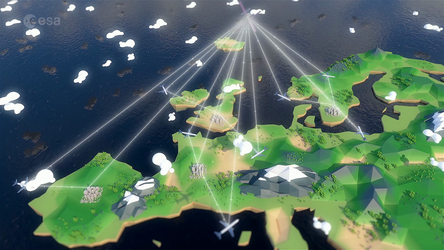ESA acts to make air travel greener
Air passengers will soon be able to cut their carbon footprint when travelling on flights that are routed using satellites.
An agreement signed today between satellite company Inmarsat and the European Satellite Services Provider, which represents air traffic controllers from seven European countries, will enable final tests of the space-based system to be conducted and evaluated. It is expected to be introduced across Europe by 2023.
ESA has worked with Inmarsat to develop a space-enabled digital alternative to traditional air traffic control that enables pilots to take more efficient trajectories, saving fuel and cutting carbon emissions.
The system – called Iris – uses satellites to exchange data with aircraft, supplementing the terrestrial communications system with digital position reports, clearances and runway conditions, sent via telecommunications satellites between cockpits and air traffic control centres.
Flight plans can be continually updated during the flight to maintain an optimal trajectory towards the destination, minimising the fuel burned and the carbon dioxide emitted.
Iris was first tested on planes flying over Europe in 2018 and debuted in the US on a new Boeing 737-9 operated by Alaska Airlines earlier this year.
Today’s agreement is between Inmarsat and the European Satellite Services Provider, a company founded by seven air navigation service providers from France, Germany, Italy, Portugal, Spain, Switzerland and the UK to operate and provide services for a satellite-based navigation system managed by the European Commission called the European Geostationary Navigation Overlay Service.
It aims to manage final testing and certification – which includes certification from the European Aviation Safety Agency ahead of commercial rollout across Europe. The agreement was signed today at the World Air Traffic Management Congress in Madrid.
Iris will implement its improvements under the European Commission’s single European sky air traffic management research programme, which promises to boost efficiency, capacity and performance of air traffic management worldwide.

John Broughton, Senior Vice President of Aircraft Operations and Safety Services at Inmarsat, said: “There is monumental support within the aviation industry for modernising air traffic management. The benefits for airlines and passengers are vast, from faster and more efficient flight routes with less delays, to improvements in environment efficiencies, including less fuel usage and carbon dioxide emissions.”
Charlotte Neyret, Chief Executive Officer of the European Satellite Services Provider, said: “The Iris programme is a game-changer for the aviation industry, providing the most advanced new technology to complement datalink communications and meet the challenge of digital, greener and sustainable air travel. The ESSP has been working on this important programme with Inmarsat and ESA for several years and we are proud to now expand our involvement. We will provide the full range of ESSP's expertise in implementing and operating mission-critical services to ensure that Iris will offer the highest quality of service to all aviation stakeholders."
Elodie Viau, Director of Telecommunications and Integrated Applications at ESA, said: “ESA is proud to work with Inmarsat and the European Satellite Services Provider to digitalise air space and reduce the environmental impact of flying, while simultaneously improving the efficiency of the aviation industry. The digitalisation of our skies will lead to a greener environment, a better passenger experience, and a more competitive European economy.”















 Germany
Germany
 Austria
Austria
 Belgium
Belgium
 Denmark
Denmark
 Spain
Spain
 Estonia
Estonia
 Finland
Finland
 France
France
 Greece
Greece
 Hungary
Hungary
 Ireland
Ireland
 Italy
Italy
 Luxembourg
Luxembourg
 Norway
Norway
 The Netherlands
The Netherlands
 Poland
Poland
 Portugal
Portugal
 Czechia
Czechia
 Romania
Romania
 United Kingdom
United Kingdom
 Slovenia
Slovenia
 Sweden
Sweden
 Switzerland
Switzerland




























